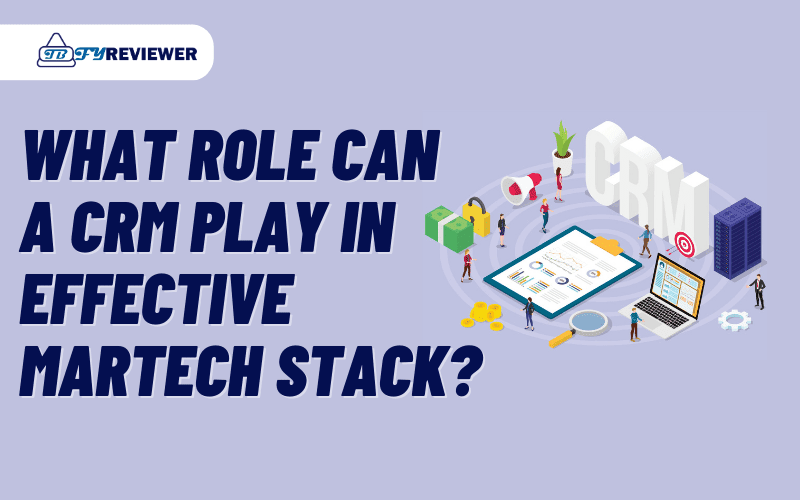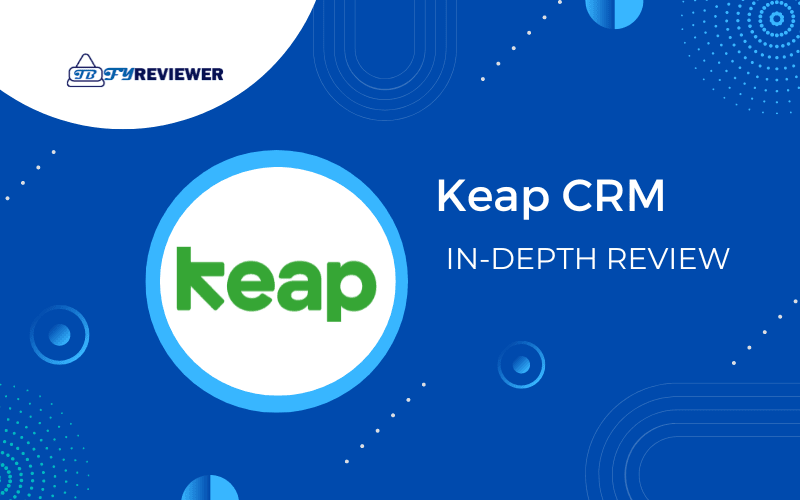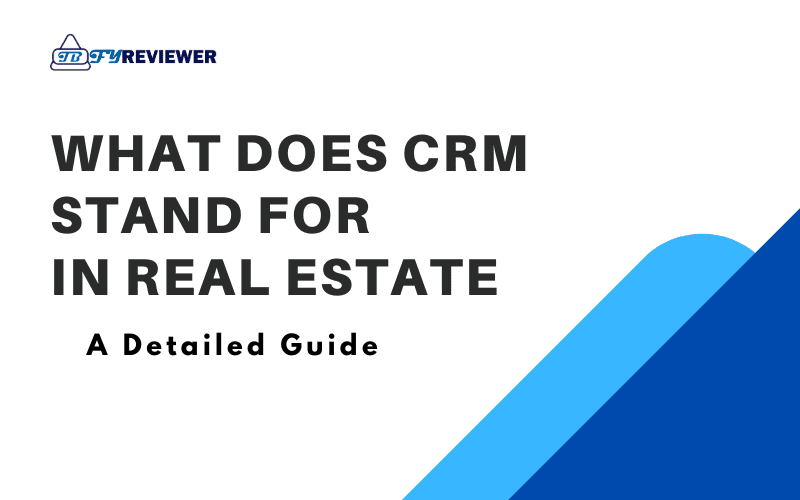Join TbfyReviewer’s newsletter to receive every new article.
What Role Can A CRM Play In Effective Martech Stack
Hossam jamjama
- May 31, 2023

What Role Can A CRM Play In Effective Martech Stack? One of the most asked questions.
In today’s digital marketing landscape, having an effective martech stack is crucial to driving business growth and success.
Marketing technology or ‘martech’ refers to the collective strategies, tools, and technologies used by businesses to attract, engage and retain customers.
A key component of a successful martech approach is the integration of a customer relationship management (CRM) tool.
In this article, we’ll explore the role a CRM can play in an effective martech stack and its importance in managing customer relationships. We’ll define what exactly a martech stack is and how a CRM tool can help in creating and maintaining one.
Whether you’re starting with your first martech stack or revamping an existing one, understanding the critical part a CRM plays will set you up for marketing success.
So, let’s dive into What role can a CRM play in effective martech stack?
Understanding CRM in Martech Stack
What is a CRM?
A CRM is a software application that helps businesses manage their interactions with customers and prospects. It allows companies to track customer information, such as contact details, purchase history, and interaction history across various touchpoints.
It provides insights into customer behavior and enables businesses to create personalized experiences that meet the needs of individual customers.
This information can help businesses understand their customers better and tailor their marketing efforts accordingly.
Types of CRM tools
There are several types of CRM tools available depending on business requirements. Some popular types are:
- Operational CRMs: These CRMs focus on operational processes such as sales automation and marketing automation, and service functions.
- Analytical CRMs: These focus on analyzing customer data to provide insights into customer behavior and preferences, and help businesses make data-driven decisions.
- Collaborative CRMs: These CRMs allow teams to collaborate on customer interactions, making it easier to manage customer relationships and provide a seamless customer experience.
Best free and paid CRM tools
when it comes to choosing CRM Software there are many free and paid CRM options available depending on business size and budget constraints. Some popular options include:
- HubSpot: A popular free option with features such as contact management and lead generation.
- Salesforce: A paid cloud-based platform that offers extensive features for sales, marketing automation, and customer service management.
- ZohoCRM: A mid-range priced option with features such as sales pipeline management and analytics.
- Microsoft Dynamics 365: A high-end option offered by Microsoft that integrates well with other Microsoft products.
You can check out our list for the best CRM software, and pick the right platform for your business.
Where does a CRM fit in the marketing technology landscape?
A martech stack is a combination of technology platforms and tools used by marketers to create, manage, and analyze marketing campaigns and workflows.
A CRM is a vital component of an effective martech stack. It integrates with other tools such as marketing automation software, social media platforms, and customer support tools to provide a seamless customer experience.
The inclusion of a CRM in a martech stack can help businesses manage customer relationships effectively by providing actionable insights into customer behavior.
By tracking customer interactions across various touchpoints and analyzing the data collected, marketers can tailor their campaigns to target specific customer segments.
Benefits of Integrating a CRM into Martech Stack
The inclusion of a CRM in your martech stack can provide numerous benefits for your business. Here are just a few:
Better customer segmentation and targeting
Segmenting customers based on their demographics, behavior, and preferences can help businesses target their marketing efforts more effectively.
A CRM tool can track customers’ interactions with the company across different channels, helping marketers understand their preferences and behaviors.
This enables businesses to create targeted marketing campaigns that resonate with specific customer segments.
Enhanced customer engagement and retention
A CRM helps businesses keep track of customers’ purchase history, preferences, and interactions with the company.
This information can help companies personalize their communication with customers and provide them with relevant content, resulting in increased engagement and customer satisfaction.
By providing a comprehensive view of the customer journey, a CRM enables businesses to engage customers at each stage of the process.
This can lead to increased customer satisfaction and loyalty over time.
Improved sales pipeline management and conversion rates
A CRM provides insights into where customers are in the sales pipeline, making it easier for sales teams to prioritize leads and close deals effectively.
This leads to increased conversion rates and revenue for the business.
Streamlined customer data collection and analysis
CRM automates the process of data collection from various sources and analyzes this data in real time on one platform.
This allows businesses to gain insights into their customers’ behavior that would be difficult or impossible to obtain otherwise.
This leads to actionable insights that can be used to inform marketing strategies and decision-making.
Choosing the Right CRM for Your Needs
Choosing the right CRM for your business is crucial. Here are some factors to consider when selecting a CRM:
Business size and type
The size and type of your business will play a critical role in choosing the right CRM. Different CRMs are designed for different-sized businesses.
Small businesses may benefit from free or low-cost options with no need for a high-end option, while larger enterprises may require more comprehensive and advanced features.
Budget constraints
Budget is also an essential factor in choosing a CRM tool. The cost of CRMs varies widely depending on the features offered.
Some CRMs offer free or low-cost options, while others can be quite expensive.
Businesses should evaluate what features they need most and select a CRM that fits their budget.
Type of integration needed
Businesses should consider how well a CRM tool integrates with other tools in their martech stack.
This helps reduce the need for manual data entry and ensures a seamless customer experience and more efficient processes.
Features and capabilities required
Different CRMs come with different features and capabilities, such as automation, lead scoring, and analytics.
Businesses should evaluate which features are most important to them before selecting a CRM.
Usability and ease of implementation
The ease of use and implementation time can vary between CRMs.
Selecting a user-friendly CRM with an intuitive interface can help reduce the learning curve for employees.
Key Features to Look for in a CRM Tool
Here are some key features to look for when selecting a CRM:
Contact management and lead generation
The ability to manage contacts and generate leads is essential in a CRM.
A good CRM should be robust in terms of contact management. It should allow businesses to store customer data centrally and provide search capabilities for easy access.
A CRM tool should also have strong lead generation capabilities to help businesses attract more leads.
Marketing automation
Marketing automation can streamline many marketing tasks by automating them.
This includes email marketing campaigns, social media engagement, and website tracking.
Sales management
Sales management capabilities allow businesses to track leads and close deals more effectively.
A good CRM should follow the sales funnel process from lead generation to closing deals.
It should also provide real-time data insights into where each prospect is in the sales cycle.
Customer service and support
Customer service and support features enable businesses to provide superior customer service and support.
A good CRM allows CS teams to engage customers promptly across different channels.
Customers expect companies to reach out within minutes via social media or messaging apps.
Analytics and Reporting
Analytics and reporting features help businesses analyze customer data to provide actionable insights.
Good reporting is vital when tracking your marketing efforts’ ROI through different funnel stages.
Such reports minimize the time spent on administrative tasks hence greater accuracy as opposed to manual reports based on raw data.
Best Practices for Implementing a CRM in Your Martech Stack
When implementing a new CRM, it’s crucial to plan properly to ensure success.
Here are some best practices for implementing a CRM in your martech stack:
Define your business requirements
Before deciding on which CRM to use, businesses should define their requirements and goals carefully. This helps select an option that meets your needs and objectives best.
Train your team on how to use the CRM tool effectively
Training is important for managing a good sales process. Your managers, sales reps, and customer service teams need to know how to use the software efficiently.
Proper training is essential to ensure efficient use of the CRM by your team.
Optimize your workflows and processes per your business needs
Aligning your workflows saves ample time spent on tasks that are not linked with driving revenue.
Make sure that the CRM adapts to your business processes, not the other way around.
Look at your process today, and isolate inefficiencies.
Integrate with other relevant tools in your martech stack
After selecting a CRM, businesses should integrate it with other tools in their martech stack to provide a seamless customer experience.
Integrating your CRM with other relevant tools ensures seamless workflows across different areas of your business.
Continuously evaluate and adjust the tool to optimize performance
Regularly evaluate the performance of the CRM to ensure that it continues to meet your business needs over time and keep up with industry changes.
A quarterly evaluation of KPIs can give an update on for instance how many deals moved from one stage to another earlier than expected if any discrepancies are noted comparing data from different tools.
Real-life Examples of How Companies Use CRM Tools as Part of Their Martech Stack
Several companies have achieved success by incorporating CRM tools into their martech stacks. Here are some examples:
Examples from B2B businesses
- Salesforce: Salesforce offers comprehensive solutions for businesses of all sizes in customer relationship management.
- Microsoft Dynamics: Microsoft D365 covers various business functions such as HR, finance, improving lead tracking, as well as enhancing productivity using machine learning/artificial intelligence capabilities.
- ZohoCRM: Zoho provides mid-range pricing options that suit small/medium organizations that require different features in line with marketing automation and sales task management.
These CRMs enable sales teams to manage leads effectively while providing insights into customer behavior.
Examples from B2C businesses
- HubSpot: One of the most popular CRMs offering free plans allowing companies to manage interactions between customers and prospects.
- Marketo: An experienced automated marketing platform that was acquired by Adobe.
- Pardot: An automation solution offered by Salesforce that primarily targets B2B businesses.
These CRMs enable businesses to provide personalized customer experiences across different channels.
Challenges & Solutions When Incorporating a CRM into Your Martech Stack
Although incorporating CRMs offers many benefits, there are some challenges that businesses can face. When incorporating a CRM into your Martech stack, you may encounter some challenges.
Here are some strategies to overcome these challenges:
Security and privacy concerns
Businesses should ensure they select a CRM with robust security features, protecting their customers’ sensitive data.
Integration issues
Proper planning is crucial when integrating a new tool into the martech stack, to minimize surprises down the line.
Integration issues can be resolved by choosing a CRM that integrates seamlessly with other relevant tools in your martech stack.
Lack of user adoption
Lack of user adoption can be resolved by providing adequate training and support to ensure that your team is using the tool effectively.
To guarantee user adoption, it’s essential to provide ample training and support to your team. Also, ensure they understand how the CRM will improve their day-to-day tasks.
Metrics to Track to Evaluate CRM Performance in Your Martech Stack
Measuring the effectiveness of a CRM tool is crucial. Here are some metrics businesses should track when evaluating how well their CRM performs as part of their martech stack:
Customer acquisition costs (CAC)
CAC measures the cost of acquiring new customers.
This metric is determined by dividing the total acquisition costs -wages allocated towards acquiring new leads or marketing campaigns- by the number of new customers acquired through such investments.
Conversion rates
Conversion rates measure how many leads are turned into customers.
This metric defines how many of your warm leads became paying customers within given time periods all through customer journey stages, regardless of sales channels.
Customer lifetime value (CLV)
CLV measures the total revenue generated by a customer over their lifetime.
This valuation measures future expected revenue production from a customer subtracted by anticipated future cost sales and marketing costs incurred while maintaining relations.
Churn rates
Churn rates measure how many customers leave the business over time.
This metric defines how many customers have ceased doing business with you and why different tools such software help solve that problem.
Conclusion
In conclusion, businesses of all sizes can benefit from incorporating a CRM into their martech stack.
A CRM offers valuable insights into customer behavior, enabling personalized experiences, and building stronger relationships.
When selecting a CRM tool, factors such as budget, integration capabilities, and usability should be considered.
Integrating a CRM plays a vital role in attracting, engaging, and retaining customers. Regularly assessing tools’ performance optimizes sales processes and highlights areas for improvement.
Overall, considering what role can a CRM play in effective martech stack is vital for any modern business seeking to optimize their marketing efforts.
- Last Update OnMay 31, 2023
- ByHossam jamjama

Hossam Jamjama
Hey, it’s Hossam. I am a full time digital marketer & an online business owner. I write guides and in-depth reviews of the best SaaS products available. To help businesses make informed decisions about picking the right one for them.
Disclosure: TbfyReviewer is a participant in various affiliate programs, which means we may earn a commission when you buy something through links on our site at no cost to you if you decide to purchase a paid plan. You can read our affiliate disclosure.
Table Of Content
- Understanding CRM in Martech Stack
- Benefits of Integrating a CRM into Martech Stack
- Choosing the Right CRM for Your Needs
- Key Features to Look for in a CRM Tool
- Best Practices for Implementing a CRM in Your Martech Stack
- Real-life Examples of How Companies Use CRM Tools as Part of Their Martech Stack
- Challenges & Solutions When Incorporating a CRM into Your Martech Stack
- Metrics to Track to Evaluate CRM Performance in Your Martech Stack
- Conclusion




